The Influence of Grain Size Gradation on Deformation and the Void Structure Evolution Mechanism of Broken Rock Mass in the Goaf
Abstract
:1. Introduction
2. Calculation Model of Particle Impact Strength Corrosion
2.1. The Proposal of the Calculation Model
2.2. Parameter Analysis of the Impacting Strength Erosion Model
2.3. Influence Ranges of Particle Impact Strength Erosion
2.4. Realization of Impacting Strength Erosion in a Particle Discrete Element Simulation
3. Establishment of a Discrete Element Numerical Model for Broken Rock Mass in Goaf
3.1. Simulation Method of the Broken Rock Mass Specimen
3.2. Size Grading Scheme of the Broken Rock Mass Specimen
3.3. Determination of the Mesoscopic Parameter
3.4. Fluid Force Embedding
3.5. Loading Method of Laterally Confined Compression (LCS)
4. Results and Discussion
4.1. Stress–Strain Curve of Broken Rock Mass in Different Size Grading Conditions
4.2. Breakage Rate of Broken Rock Mass in Different Size Grading Conditions
4.3. Fracture Morphology of Broken Rock Mass
4.4. Porosity along the Vertical Direction
5. Conclusions
Author Contributions
Funding
Institutional Review Board Statement
Informed Consent Statement
Data Availability Statement
Conflicts of Interest
References
- Guo, P.; Zheng, L.; Sun, X.; He, M.; Wang, Y.; Shang, J. Sustainability evaluation model of geothermal resources in abandoned coal mine. Appl. Therm. Eng. 2018, 144, 804–811. [Google Scholar] [CrossRef]
- Peralta, R.E.; Breede, K.; Falcone, G. Geothermal heat recovery from abandoned mines: A systematic review of projects implemented worldwide and a methodology for screening new projects. Environ. Earth Sci. 2015, 73, 6783–6795. [Google Scholar] [CrossRef]
- Al-Habaibeh, A.; Athresh, A.P.; Parker, K. Performance analysis of using mine water from an abandoned coal mine for heating of buildings using an open loop based single shaft GSHP system. Appl. Energy 2018, 211, 393–402. [Google Scholar] [CrossRef]
- Opt, V.P.; Demollin-Schneiders, E. The mine water project Heerlen, the Netherlands—Low exergy in practice. In Proceedings of the 6th International Conference on Indoor Air Quality, Ventilation & Energy Conservation in Buildings (IAQVEC 2007), Sendai, Japan, 28–31 October 2007; pp. 28–31. [Google Scholar]
- Yuan, L.; Zhang, T.; Zhang, Q.H.; Jiang, B.; Lv, X.; Li, S.; Fu, Q. Construction of green low-carbon and multi-energy complementary system for abandoned mines under global carbon neutrality. J. China Coal Soc. 2022, 47, 2131–2139. (In Chinese) [Google Scholar]
- Zhai, X.; Wang, G.; Wu, J.; Bi, Y. Goaf compaction evaluation based on integrity and permeability measurement of the overburden strata. Teh. Vjesn. 2019, 26, 510–517. [Google Scholar]
- Wang, C.; Jiang, N.; Shen, B.; Sun, X.; Zhang, B.; Lu, Y.; Li, Y. Distribution and evolution of residual voids in longwall old goaf. Geomech. Eng. 2019, 19, 105–114. [Google Scholar]
- Xie, H.; Zhao, J.W.; Zhou, H.W.; Ren, S.H.; Zhang, R.X. Secondary utilizations and perspectives of mined underground space. Tunn. Undergr. Space Technol. 2020, 96, 103129. [Google Scholar] [CrossRef]
- Feng, M.; Wu, J.; Ma, D.; Ni, X.; Yu, B.; Chen, Z. Experimental investigation on the seepage property of saturated broken red sandstone of continuous gradation. Bull. Eng. Geol. Environ. 2018, 77, 1167–1178. [Google Scholar] [CrossRef]
- Zhang, L.; Zhu, J. Analysis of mechanical strength and failure morphology of prefabricated closed cracked rock mass under uniaxial compression. Geotech. Geol. Eng. 2020, 38, 4905–4915. [Google Scholar] [CrossRef]
- Li, B.; Liang, Y.; Zhang, L.; Zou, Q. Breakage law and fractal characteristics of broken coal and rock masses with different mixing ratios during compaction. Energy Sci. Eng. 2019, 7, 1000–1015. [Google Scholar] [CrossRef]
- Zhang, C.; Ren, Z.; Hao, D.; Zhang, T. Numerical Simulation of Particle Size Influence on the Breakage Mechanism of Broken Coal. Arab. J. Sci. Eng. 2020, 45, 9171–9185. [Google Scholar] [CrossRef]
- Meng, F.; Pu, H.; Dintwe, T.K.; Sasaoka, T.; Xu, J. Creep and breakage behavior of broken rock in the caved zone of abundant mines under triaxial compression condition. Energy Rep. 2022, 8, 14517–14532. [Google Scholar] [CrossRef]
- Zhang, C.; Bai, Q.; Zhu, C. A methodology for determining the size distribution of broken rock masses in longwall mining goaf. Geomech. Geophys. Geo-Energy Geo-Resour. 2022, 8, 113. [Google Scholar] [CrossRef]
- Li, Q.; Ma, D.; Zhang, Y.; Liu, Y.; Ma, Y.; Hu, D. Insights into controlling factors of pore structure and hydraulic properties of broken rock mass in a geothermal reservoir. Lithosphere 2021, 2021, 3887832. [Google Scholar] [CrossRef]
- Huang, Y.; Li, J.; Ma, D.; Gao, H.; Guo, Y.; Ouyang, S. Triaxial compression behaviour of gangue solid wastes under effects of particle size and confining pressure. Sci. Total Environ. 2019, 693, 133607. [Google Scholar] [CrossRef] [PubMed]
- Li, M.; Zhang, J.; Meng, G.; Gao, Y.; Li, A. Testing and modelling creep compression of waste rocks for backfill with different lithologies. Int. J. Rock Mech. Min. Sci. 2020, 125, 104170. [Google Scholar] [CrossRef]
- Li, C.; Yao, B.; Ma, Q. Numerical simulation study of variable-mass permeation of the broken rock mass under different cementation degrees. Adv. Civ. Eng. 2018, 1, 3592851. [Google Scholar] [CrossRef]
- Chen, X.; Gao, W.; Hu, C.; Wang, C.; Zhou, C. Study on macro–micro mechanical behavior of broken rock mass using numerical tests with discrete element method. Comput. Part. Mech. 2023, 10, 691–705. [Google Scholar] [CrossRef]
- Wang, Y.; Song, E.X.; Zhao, Z. Particle mechanics modeling of the effect of aggregate shape on creep of durable rockfills. Comput. Geotech. 2018, 98, 114–131. [Google Scholar] [CrossRef]
- Meng, F.; Pu, H.; Sasaoka, T.; Shimada, H.; Liu, S.; Dintwe, T.K.; Sha, Z. Time effect and prediction of broken rock bulking coefficient on the base of particle discrete element method. Int. J. Min. Sci. Technol. 2021, 31, 643–651. [Google Scholar] [CrossRef]
- Zhang, C.; Zhao, Y.; Bai, Q. 3D DEM method for compaction and breakage characteristics simulation of broken rock mass in goaf. Acta Geotech. 2022, 17, 2765–2781. [Google Scholar] [CrossRef]
- El-Zehairy, A.A.; Nezhad, M.M.; Joekar-Niasar, V.; Guymer, I.; Kourra, N.; Williams, M.A. Pore-network modelling of non-Darcy flow through heterogeneous porous media. Adv. Water Resour. 2019, 131, 103–378. [Google Scholar] [CrossRef]
- Li, B.; Liang, Y.; Zhang, L.; Zou, Q. Experimental investigation on compaction characteristics and permeability evolution of broken coal. Int. J. Rock Mech. Min. Sci. 2019, 118, 63–76. [Google Scholar] [CrossRef]
- Wu, Y.; Geng, H.; Hao, G.; Li, D. Experimental study on heat exchange efficiency of rock bed heat storage system based on broken rock mass. Energy Rep. 2022, 8, 12456–12465. [Google Scholar] [CrossRef]
- Meng, F.; Pu, H.; Ni, H.; Bian, Z. Research on re-fracturing mechanism and cavity structure evolution characteristics of broken rock mass in goaf of closed mine. Coal Sci. Technol. 2024, 52, 104–114. (In Chinese) [Google Scholar]
- Potyondy, D.O. Simulating stress corrosion with a bonded-particle model for rock. Int. J. Min. Sci. Technol. 2007, 44, 677–691. [Google Scholar] [CrossRef]
- Tran, T.H.; Vénier, R.; Cambou, B. Discrete modelling of rockageing in rockfill dams. Comput. Geotech. 2009, 36, 264–275. [Google Scholar] [CrossRef]
- Parsi, M.; Najmi, K.; Najafifard, F.; Hassani, S.; McLaury, B.S.; Shirazi, S.A. A comprehensive review of solid particle erosion modeling for oil and gas wells and pipelines applications. J. Nat. Gas Sci. Eng. 2014, 21, 850–873. [Google Scholar] [CrossRef]
- Bitter, J.G.A. A study of erosion phenomena: Part I. Wear 1963, 6, 5–21. [Google Scholar] [CrossRef]
- Bitter, J.G.A. A study of erosion phenomena: Part II. Wear 1963, 6, 169–190. [Google Scholar] [CrossRef]
- Gong, C.; Zhang, L.; Ma, C.; Tian, Z. Analysis brittleness index based on fracture energy ratio of rock mass. Ming Res. Dev. 2022, 42, 82–89. (In Chinese) [Google Scholar]
- Liu, W.; Meng, F.; Pu, H.; Wang, J.; Zhang, G.; Yi, Q. The seepage-creep numerical simulation model of coal measures sandstone based on particle discrete element. Geofluids 2022, 1, 5981768. [Google Scholar] [CrossRef]
- Iraji, S.; Soltanmohammadi, R.; Munoz, E.R.; Basso, M.; Vidal, A.C. Core scale investigation of fluid flow in the heterogeneous porous media based on X-ray computed tomography images: Upscaling and history matching approaches. Geoenergy Sci. Eng. 2023, 225, 211716. [Google Scholar] [CrossRef]
- Iraji, S.; De Almeida, T.R.; Munoz, E.R.; Basso, M.; Vidal, A.C. The impact of heterogeneity and pore network characteristics on single and multi-phase fluid propagation in complex porous media: An X-ray computed tomography study. Pet. Sci. 2024, 21, 1719–1738. [Google Scholar] [CrossRef]
- Soltanmohammadi, R.; Iraji, S.; de Almeida, T.R.; Basso, M.; Munoz, E.R.; Vidal, A.C. Investigation of pore geometry influence on fluid flow in heterogeneous porous media: A pore-scale study. Energy Geosci. 2024, 5, 100222. [Google Scholar] [CrossRef]
- Zhang, Y.; Shao, Z.; Wei, W.; Qiao, R. PFC simulation of crack evolution and energy conversion during basalt failure process. J. Geophys. Eng. 2019, 16, 639–651. [Google Scholar] [CrossRef]
- Wang, S.; Li, X.; Wang, D. Void fraction distribution in overburden disturbed by longwall mining of coal. Environ. Earth Sci. 2016, 75, 151. [Google Scholar] [CrossRef]
- Guo, Y.; Qin, Y.; Chen, P.; Xu, N. Simulation of the Compaction behavior and the water permeability evolution of broken rock masses of different shapes in a goaf. Water 2023, 15, 1190. [Google Scholar] [CrossRef]
- Fan, L.; Liu, S. A conceptual model to characterize and model compaction behavior and permeability evolution of broken rock mass in coal mine gobs. Int. J. Coal Geol. 2017, 172, 60–70. [Google Scholar] [CrossRef]
- Ma, W.; Wang, T. Experimental study of shear strength features of regenerated rock mass compacted and consolidated by broken soft rocks. KSCE J. Civ. Eng. 2019, 23, 1839–1848. [Google Scholar] [CrossRef]
- Zhao, Y.; Zhao, G.; Zhou, J.; Ma, J.; Cai, X. Failure mechanism analysis of rock in particle discrete element method simulation based on moment tensors. Comput. Geotech. 2021, 136, 104215. [Google Scholar] [CrossRef]
- Petružálek, M.; Jechumtálová, Z.; Šílený, J.; Kolář, P.; Svitek, T.; Lokajíček, T.; Turková, I.; Kotrlý, M.; Onysko, R. Application of the shear-tensile source model to acoustic emissions in Westerly granite. Int. J. Rock Mech. Min. Sci. 2020, 128, 104246. [Google Scholar] [CrossRef]
- Nunziante, L.; Gesualdo, A.; Minutolo, V. On the local collapse in soft rock bank cavities. J. Geotech. Geoenviron. Eng. ASCE 2001, 127, 1037–1042. [Google Scholar]
- Nunziante, L.; Gesualdo, A.; Minutolo, V. A kind of failure in Mohr-Coulomb soil cavities. Can. Geotech. J. 2001, 38, 1314–1320. [Google Scholar]
- Xunjian, H.U.; Kang, B.I.; Jian, L.I.; Ming, C.H.; Yue, C.E.; Zhenping, L.I. Particle flow simulation of the influence of granite crystal size distribution on acoustic emission characteristics. J. China Coal Soc. 2021, 46, 721–730. (In Chinese) [Google Scholar]
- Yan, Z.; Dai, F.; Liu, Y.; Feng, P. Experimental and numerical investigation on the mechanical properties and progressive failure mechanism of intermittent multi-jointed rock models under uniaxial compression. Arab. J. Geosci. 2019, 12, 681. [Google Scholar] [CrossRef]
- Zhang, C.; Jia, S.; Bai, Q.; Zhang, H.; Chen, Y.; Jiao, Y. CFD-DEM coupled simulation of broken rock mass movement during water seepage in an underground goaf reservoir. Mine Water Environ. 2021, 40, 1048–1060. [Google Scholar] [CrossRef]
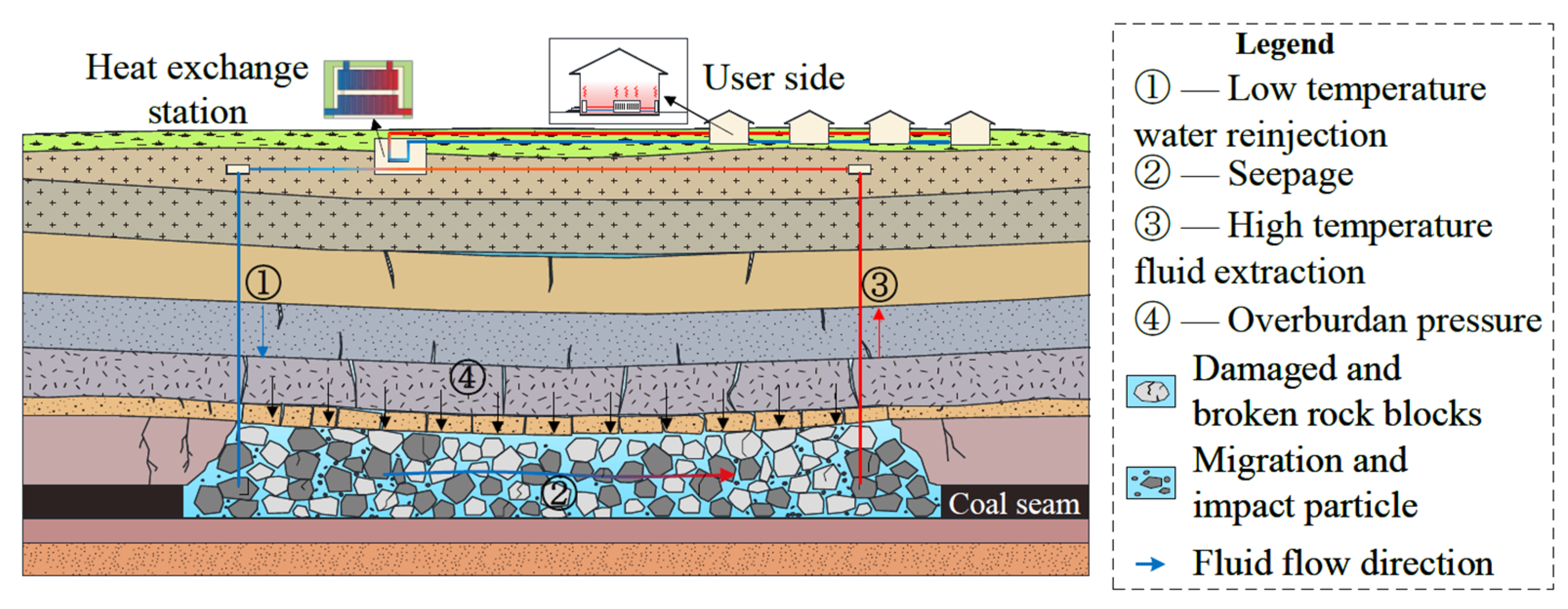



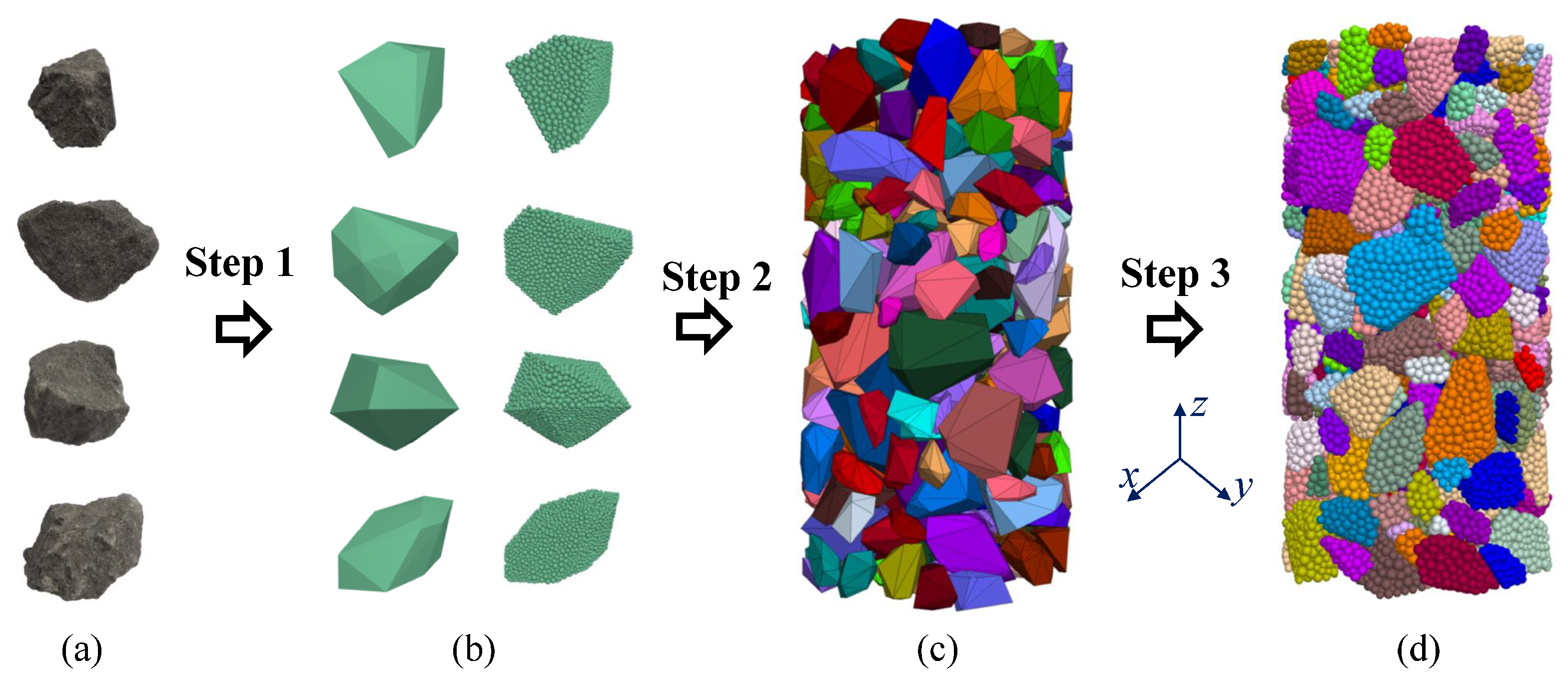
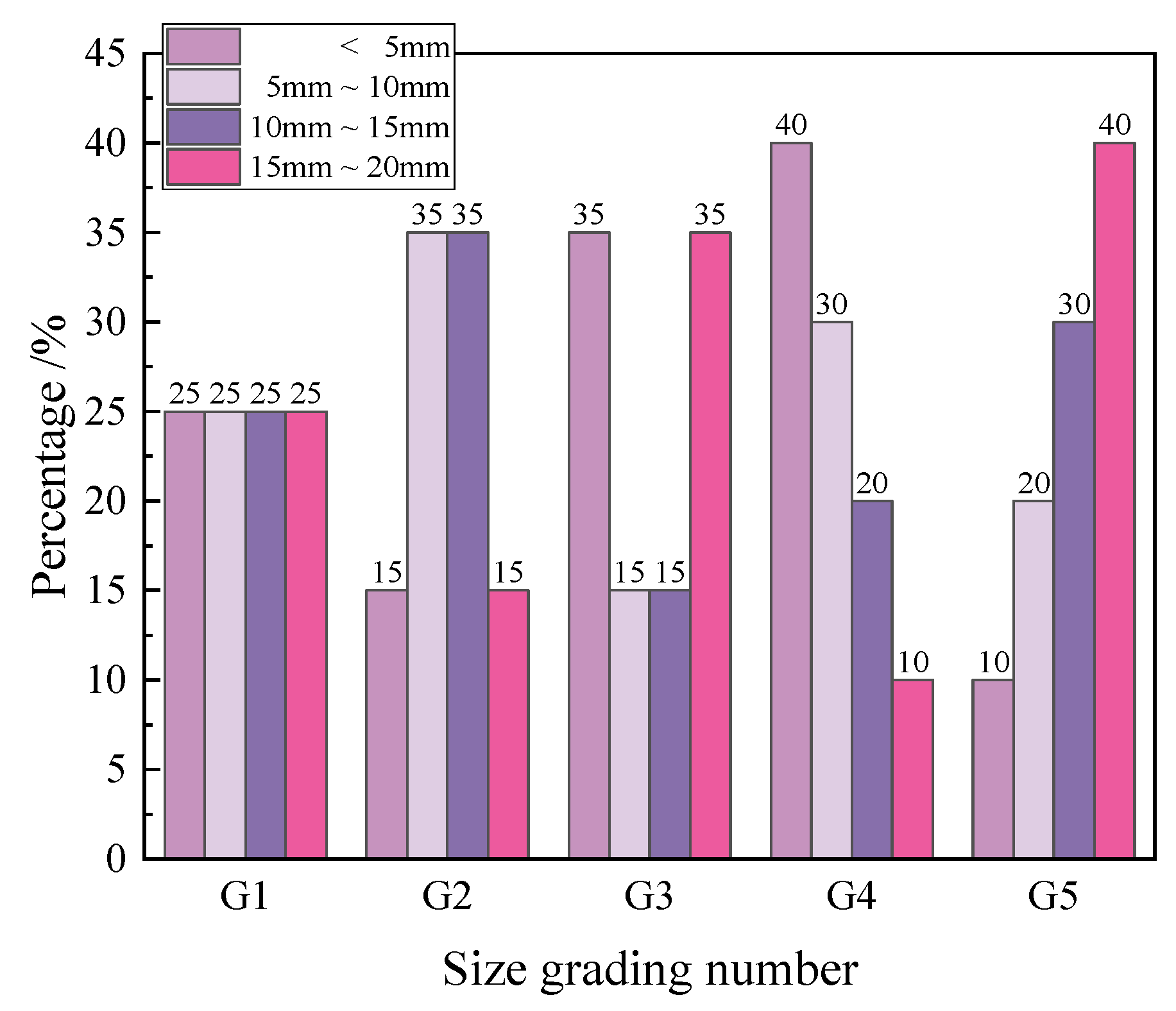

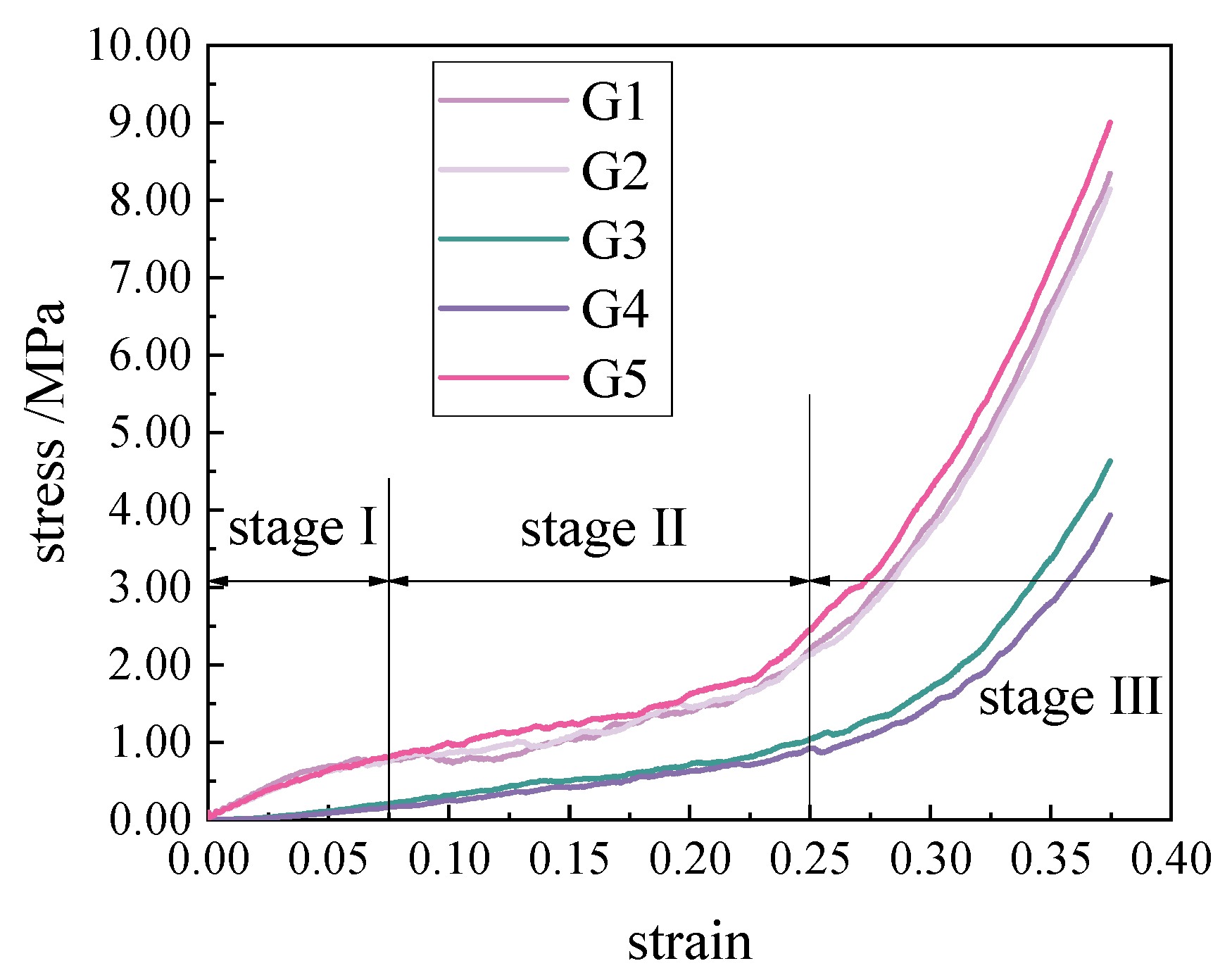
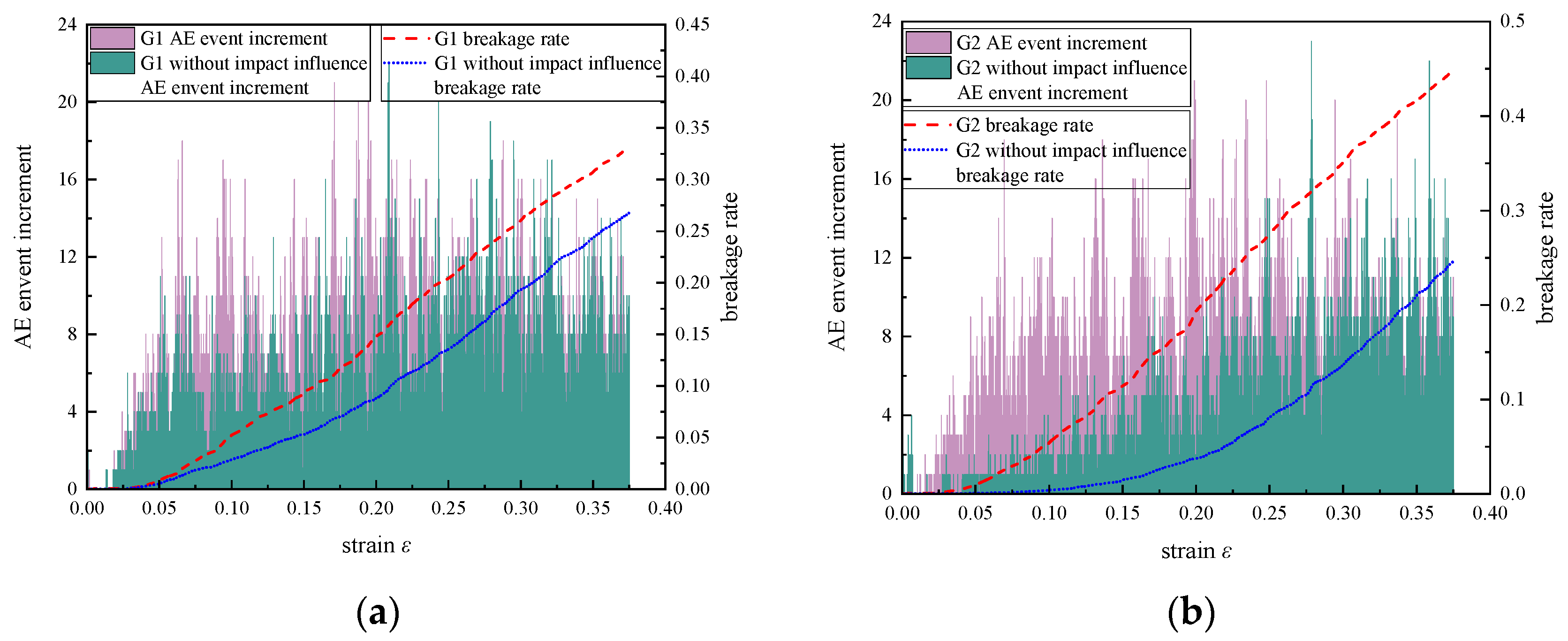

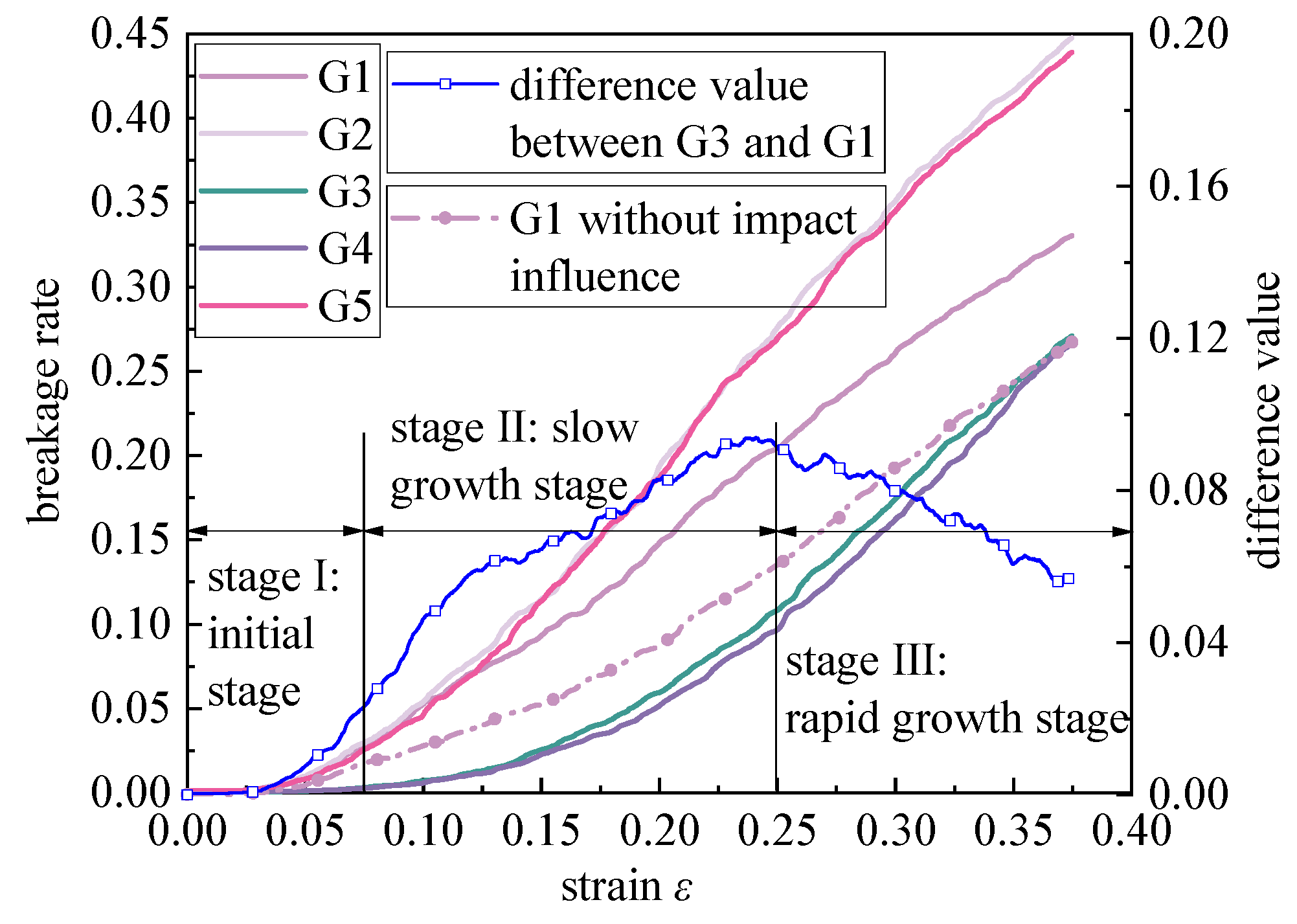

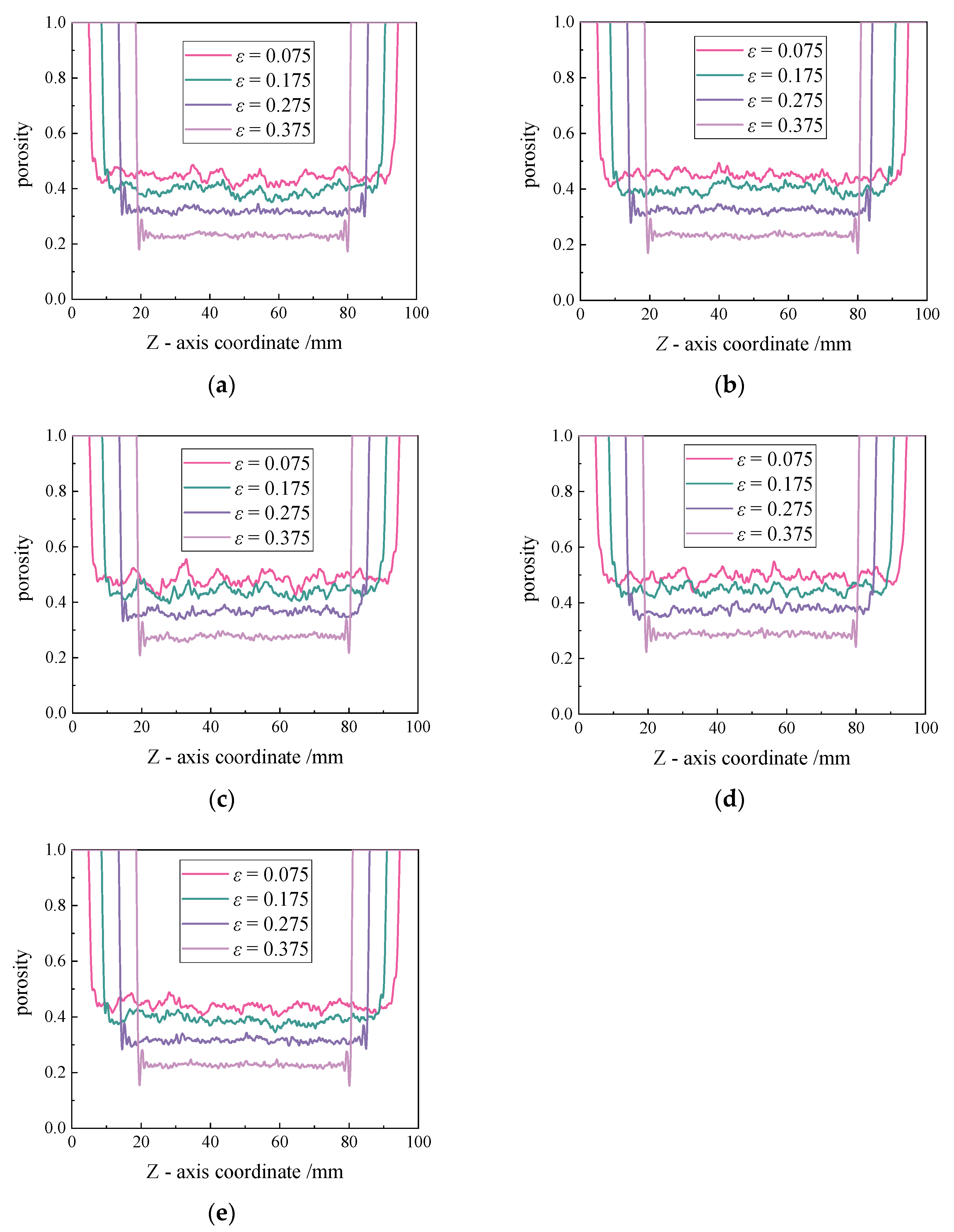
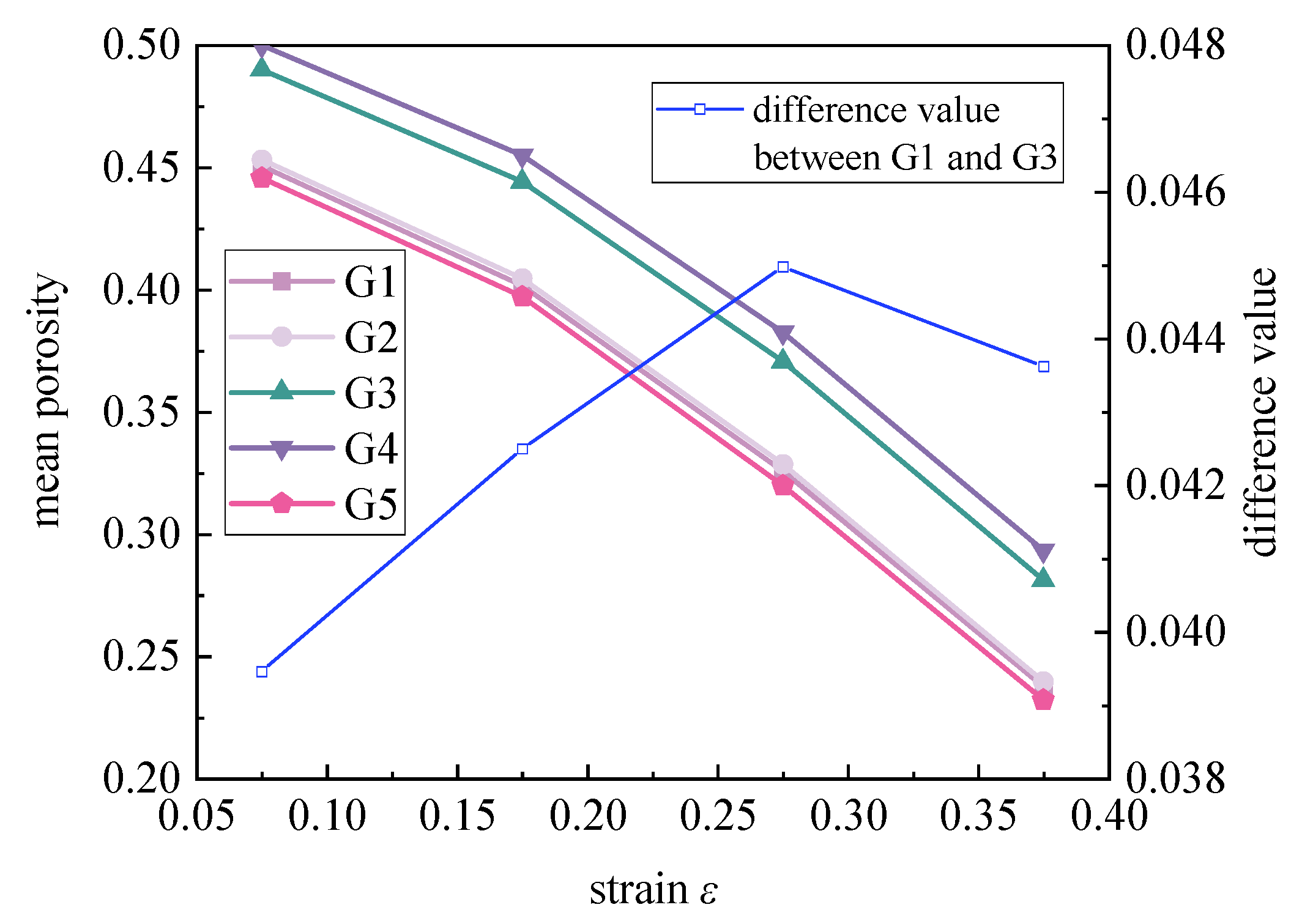
| Mesoscopic Parameters | Parameter Meaning | Parameter Value |
|---|---|---|
| ρp | Particle density | 2700 (kg/m3) |
| deform_emod | Linear contact modulus | 5.3 (GPa) |
| pb_deform_emod | Effective modulus of parallel bond | 49.7 (GPa) |
| pb_ten | Tangential strength | 43 (MPa) |
| pb_coh | Normal strength | 52 (MPa) |
| kratio | Stiffness ratio | 1.2 |
Disclaimer/Publisher’s Note: The statements, opinions and data contained in all publications are solely those of the individual author(s) and contributor(s) and not of MDPI and/or the editor(s). MDPI and/or the editor(s) disclaim responsibility for any injury to people or property resulting from any ideas, methods, instructions or products referred to in the content. |
© 2024 by the authors. Licensee MDPI, Basel, Switzerland. This article is an open access article distributed under the terms and conditions of the Creative Commons Attribution (CC BY) license (https://creativecommons.org/licenses/by/4.0/).
Share and Cite
Meng, F.; Liu, W.; Pu, H.; Li, M.; Chen, Y. The Influence of Grain Size Gradation on Deformation and the Void Structure Evolution Mechanism of Broken Rock Mass in the Goaf. Appl. Sci. 2024, 14, 6764. https://doi.org/10.3390/app14156764
Meng F, Liu W, Pu H, Li M, Chen Y. The Influence of Grain Size Gradation on Deformation and the Void Structure Evolution Mechanism of Broken Rock Mass in the Goaf. Applied Sciences. 2024; 14(15):6764. https://doi.org/10.3390/app14156764
Chicago/Turabian StyleMeng, Fanfei, Wang Liu, Hai Pu, Ming Li, and Yanlong Chen. 2024. "The Influence of Grain Size Gradation on Deformation and the Void Structure Evolution Mechanism of Broken Rock Mass in the Goaf" Applied Sciences 14, no. 15: 6764. https://doi.org/10.3390/app14156764





